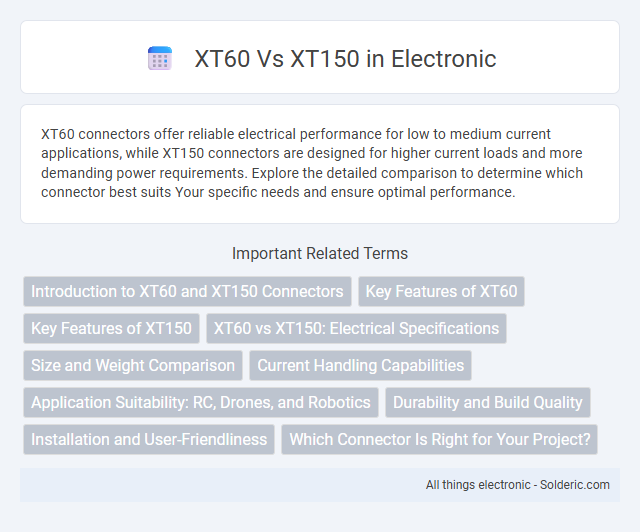XT60 connectors offer reliable electrical performance for low to medium current applications, while XT150 connectors are designed for higher current loads and more demanding power requirements. Explore the detailed comparison to determine which connector best suits Your specific needs and ensure optimal performance.
Comparison Table
| Feature | XT60 | XT150 |
|---|---|---|
| Current Rating | 60A continuous | 150A continuous |
| Connector Type | 2-pin, bullet style | 2-pin, bullet style |
| Wire Size Compatibility | Up to 12AWG | Up to 6AWG |
| Voltage Rating | Up to 500V | Up to 500V |
| Dimensions | 21.6mm x 15.4mm x 8.2mm | 41.5mm x 27mm x 12mm |
| Weight | Approx. 4 grams | Approx. 28 grams |
| Application | Medium current RC models, drones, batteries | High current electric vehicles, industrial use, large batteries |
| Operating Temperature | -20degC to 120degC | -20degC to 120degC |
| Price Range | Low | Higher |
Introduction to XT60 and XT150 Connectors
XT60 and XT150 connectors are high-current electrical connectors widely used in RC vehicles, drones, and electric devices for reliable power delivery. The XT60 is designed to handle currents up to 60 amps, featuring a compact size and gold-plated connectors for minimal resistance and heat build-up. XT150 connectors accommodate higher current loads up to 150 amps, making them suitable for larger batteries and high-power applications where enhanced durability and secure connections are critical.
Key Features of XT60
XT60 connectors feature high-current capability up to 60 amps, ensuring reliable power delivery for medium-sized batteries and RC models. Constructed with durable nylon and gold-plated contacts, they offer excellent conductivity and heat resistance for stable performance. You benefit from secure, tight fits that prevent accidental disconnections during operation.
Key Features of XT150
The XT150 features a higher current rating of 150 amps compared to the XT60's 60 amps, making it ideal for high-powered applications such as large drones and RC vehicles. Its robust design includes gold-plated contacts for enhanced conductivity and reduced resistance, ensuring efficient power transfer and minimal heat generation. The XT150's larger size and secure locking mechanism provide improved durability and reliability under demanding electrical loads.
XT60 vs XT150: Electrical Specifications
The XT60 and XT150 connectors differ primarily in their current handling capabilities, with the XT60 rated for 60 amps continuous current and the XT150 supporting up to 150 amps, making it suitable for higher power applications. Both connectors operate at similar voltage ranges, but the XT150's larger size and thicker contacts reduce resistance and heat buildup during heavy loads. Choosing the right connector depends on your device's power requirements to ensure efficiency and safety in electrical connections.
Size and Weight Comparison
XT60 connectors are compact and lightweight, measuring approximately 21mm x 16mm and weighing around 3 grams, making them ideal for smaller drones and RC vehicles. XT150 connectors are significantly larger and heavier, roughly 46mm x 32mm in size and weighing about 30 grams, designed to handle higher currents in larger electric models or industrial applications. Your choice depends on the balance between power requirements and the need to minimize size and weight for optimal performance.
Current Handling Capabilities
XT60 connectors are designed to handle continuous currents up to 60 amps, making them suitable for most standard RC applications and small drones. XT150 connectors support significantly higher current loads, typically up to 150 amps, which makes them ideal for high-power electric vehicles and large battery packs. The difference in current handling capabilities is due to the thicker gauge wires and larger contact surfaces in XT150 connectors, enabling safer high-current transmission without overheating.
Application Suitability: RC, Drones, and Robotics
XT60 connectors are ideal for small to medium RC models, drones, and robotics projects requiring up to 60A current, ensuring reliable power delivery with minimal voltage drop. XT150 connectors handle higher currents up to 150A, making them suitable for larger drones, heavy-duty RC vehicles, and advanced robotics that demand robust and stable electrical connections. Choosing the right connector depends on Your device's power requirements and ensuring safety and performance in demanding applications.
Durability and Build Quality
The XT150 connector offers enhanced durability compared to the XT60, featuring a thicker housing made from high-temperature nylon that resists melting and deformation under heavy loads. Gold-plated copper contacts in both connectors ensure reliable conductivity, but the XT150's larger contact surface area and robust design improve performance in high-current applications. Reinforced solder joints and precision molding techniques in the XT150 provide superior mechanical strength, making it ideal for demanding environments and frequent handling.
Installation and User-Friendliness
The XT60 connector offers straightforward installation with a compact design, making it ideal for smaller RC models and easier for hobbyists to solder and assemble. In contrast, the XT150 is larger and designed for higher current applications, requiring more careful handling during installation to ensure secure connections and prevent damage. Both connectors feature a polarized housing that minimizes user error, but the XT60's simplicity enhances overall user-friendliness for beginners and moderate power setups.
Which Connector Is Right for Your Project?
The XT60 connector is ideal for small to medium-sized RC projects and drones, handling currents up to 60A with secure, reliable connections. The XT150 supports higher current demands up to 150A, making it suitable for larger electric vehicles and high-power battery setups. Choosing between XT60 and XT150 depends on your project's current requirements, size, and voltage specifications to ensure safety and performance.
XT60 vs XT150 Infographic

 solderic.com
solderic.com